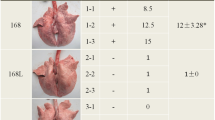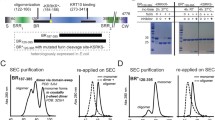Abstract
Pneumocystis carinii (Pc) adhesion to alveolar epithelial cells is well established and is thought to be a prerequisite for the initiation of Pneumocystis pneumonia. Pc binding events occur in part through the major Pc surface glycoprotein Msg, as well as an integrin-like molecule termed PcInt1. Recent data from the Pc sequencing project also demonstrate DNA sequences homologous to other genes important in Candida spp. binding to mammalian host cells, as well as organism binding to polystyrene surfaces and in biofilm formation. One of these genes, flo8, a transcription factor needed for downstream cAMP/PKA-pathway-mediated activation of the major adhesion/flocculin Flo11 in yeast, was cloned from a Pc cDNA library utilizing a partial sequence available in the Pc genome database. A CHEF blot of Pc genomic DNA yielded a single band providing evidence this gene is present in the organism. BLASTP analysis of the predicted protein demonstrated 41 % homology to the Saccharomyces cerevisiae Flo8. Northern blotting demonstrated greatest expression at pH 6.0–8.0, pH comparable to reported fungal biofilm milieu. Western blot and immunoprecipitation assays of PcFlo8 protein in isolated cyst and tropic life forms confirmed the presence of the cognate protein in these Pc life forms. Heterologous expression of Pcflo8 cDNA in flo8Δ-deficient yeast strains demonstrated that the Pcflo8 was able to restore yeast binding to polystyrene and invasive growth of yeast flo8Δ cells. Furthermore, Pcflo8 promoted yeast binding to HEK293 human epithelial cells, strengthening its functional classification as a Flo8 transcription factor. Taken together, these data suggest that PcFlo8 is expressed by Pc and may exert activity in organism adhesion and biofilm formation.








Similar content being viewed by others
Abbreviations
- Pc:
-
Pneumocystis carinii
- RACE:
-
Rapid amplification of cDNA ends
- ANOVA:
-
Analysis of variance
- SC:
-
Synthetic complete media
- CHEF:
-
Contour-clamped homogeneous electric field
References
Thomas CF Jr, Limper AH (2004) Pneumocystis pneumonia. New Engl J med 350(24):2487–2498. doi:10.1056/NEJMra032588
Sloand E, Laughon B, Armstrong M, Bartlett MS, Blumenfeld W, Cushion M, Kalica A, Kovacs JA, Martin W, Pitt E et al (1993) The challenge of Pneumocystis carinii culture. J Eukaryot Microbiol 40(2):188–195
Kottom TJ, Kohler JR, Thomas CF Jr, Fink GR, Limper AH (2003) Lung epithelial cells and extracellular matrix components induce expression of Pneumocystis carinii STE20, a gene complementing the mating and pseudohyphal growth defects of STE20 mutant yeast. Infect Immun 71(11):6463–6471
Kottom TJ, Limper AH (2013) The Pneumocystis Ace2 transcription factor regulates cell wall-remodeling genes and organism virulence. J Biol Chem 288(33):23893–23902. doi:10.1074/jbc.M113.471243
Cushion MT, Collins MS (2011) Susceptibility of Pneumocystis to echinocandins in suspension and biofilm cultures. Antimicrob Agents Chemother 55(10):4513–4518. doi:10.1128/AAC.00017-11
Cushion MT, Collins MS, Linke MJ (2009) Biofilm formation by Pneumocystis spp. Eukaryot Cell 8(2):197–206. doi:10.1128/EC.00202-08
Reynolds TB, Fink GR (2001) Bakers’ yeast, a model for fungal biofilm formation. Science 291(5505):878–881. doi:10.1126/science.291.5505.878
Li F, Palecek SP (2003) EAP1, a Candida albicans gene involved in binding human epithelial cells. Eukaryot Cell 2(6):1266–1273
Cao F, Lane S, Raniga PP, Lu Y, Zhou Z, Ramon K, Chen J, Liu H (2006) The Flo8 transcription factor is essential for hyphal development and virulence in Candida albicans. Mol Biol Cell 17(1):295–307. doi:10.1091/mbc.E05-06-0502
Krajicek BJ, Kottom TJ, Villegas L, Limper AH (2010) Characterization of the PcCdc42 small G protein from Pneumocystis carinii, which interacts with the PcSte20 life cycle regulatory kinase. Am J Physiol Lung Cell Mol Physiol 298(2):L252–L260. doi:10.1152/ajplung.00191.2009
Burgess JW, Kottom TJ, Limper AH (2008) Pneumocystis carinii exhibits a conserved meiotic control pathway. Infect Immun 76(1):417–425. doi:10.1128/IAI.00986-07
Thomas CF, Anders RA, Gustafson MP, Leof EB, Limper AH (1998) Pneumocystis carinii contains a functional cell-division-cycle Cdc2 homologue. Am J Respir Cell Mol Biol 18(3):297–306. doi:10.1165/ajrcmb.18.3.3122
Roberts RL, Fink GR (1994) Elements of a single MAP kinase cascade in Saccharomyces cerevisiae mediate two developmental programs in the same cell type: mating and invasive growth. Genes Dev 8(24):2974–2985
Pan X, Heitman J (2002) Protein kinase A operates a molecular switch that governs yeast pseudohyphal differentiation. Mol Cell Biol 22(12):3981–3993
Conner J, Liu Z (2000) LEUNIG, a putative transcriptional corepressor that regulates AGAMOUS expression during flower development. Proc Natl Acad Sci USA 97(23):12902–12907. doi:10.1073/pnas.230352397
Emes RD, Ponting CP (2001) A new sequence motif linking lissencephaly, treacher collins and oral-facial-digital type 1 syndromes, microtubule dynamics and cell migration. Hum Mol Genet 10(24):2813–2820
Kim TS, Kim HY, Yoon JH, Kang HS (2004) Recruitment of the Swi/Snf complex by Ste12-Tec1 promotes Flo8-Mss11-mediated activation of STA1 expression. Mol Cell Biol 24(21):9542–9556. doi:10.1128/MCB.24.21.9542-9556.2004
Kottom TJ, Han J, Zhang Z, Limper AH (2011) Pneumocystis carinii expresses an active Rtt109 histone acetyltransferase. Am J Respir Cell Mol Biol 44(6):768–776. doi:10.1165/rcmb.2009-0443OC
Kottom TJ, Limper AH (2004) Pneumocystis carinii cell wall biosynthesis kinase gene CBK1 is an environmentally responsive gene that complements cell wall defects of cbk-deficient yeast. Infect Immun 72(8):4628–4636. doi:10.1128/IAI.72.8.4628-4636.2004
Kottom TJ, Thomas CF Jr, Limper AH (2001) Characterization of Pneumocystis carinii PHR1, a pH-regulated gene important for cell wall Integrity. J Bacteriol 183(23):6740–6745. doi:10.1128/JB.183.23.6740-6745.2001
Ramage G, Rajendran R, Sherry L, Williams C (2012) Fungal biofilm resistance. Int J Microbiol 2012:528521. doi:10.1155/2012/528521
Limper AH, Thomas CF Jr, Anders RA, Leof EB (1997) Interactions of parasite and host epithelial cell cycle regulation during Pneumocystis carinii pneumonia. J Lab Clini Med 130(2):132–138
Kottom TJ, Limper AH (2000) Cell wall assembly by Pneumocystis carinii. Evidence for a unique gsc-1 subunit mediating beta -1,3-glucan deposition. J Biol Chem 275(51):40628–40634. doi:10.1074/jbc.M002103200
Kobayashi O, Suda H, Ohtani T, Sone H (1996) Molecular cloning and analysis of the dominant flocculation gene FLO8 from Saccharomyces cerevisiae. Mol Genet Genomics 251(6):707–715
Fichtner L, Schulze F, Braus GH (2007) Differential Flo8p-dependent regulation of FLO1 and FLO11 for cell-cell and cell-substrate adherence of S. cerevisiae S288c. Mol Microbiol 66(5):1276–1289. doi:10.1111/j.1365-2958.2007.06014.x
Rupp S, Summers E, Lo HJ, Madhani H, Fink G (1999) MAP kinase and cAMP filamentation signaling pathways converge on the unusually large promoter of the yeast FLO11 gene. EMBO J 18(5):1257–1269. doi:10.1093/emboj/18.5.1257
Li Y, Su C, Mao X, Cao F, Chen J (2007) Roles of Candida albicans Sfl1 in hyphal development. Eukaryot Cell 6(11):2112–2121. doi:10.1128/EC.00199-07
Singh B, Fleury C, Jalalvand F, Riesbeck K (2012) Human pathogens utilize host extracellular matrix proteins laminin and collagen for adhesion and invasion of the host. FEMS Microbiol Rev 36(6):1122–1180. doi:10.1111/j.1574-6976.2012.00340.x
Yang W, Yan L, Wu C, Zhao X, Tang J (2014) Fungal invasion of epithelial cells. Microbiol Res. doi:10.1016/j.micres.2014.02.013
Kelly MN, Shellito JE (2010) Current understanding of Pneumocystis immunology. Future Microbiol 5(1):43–65. doi:10.2217/fmb.09.116
Ahuja J, Kanne JP (2014) Thoracic infections in immunocompromised patients. Radiol Clin North Am 52(1):121–136. doi:10.1016/j.rcl.2013.08.010
Limper AH, Edens M, Anders RA, Leof EB (1998) Pneumocystis carinii inhibits cyclin-dependent kinase activity in lung epithelial cells. J Clin Invest 101(5):1148–1155. doi:10.1172/JCI659
Kottom TJ, Kennedy CC, Limper AH (2008) Pneumocystis PCINT1, a molecule with integrin-like features that mediates organism adhesion to fibronectin. Mol Microbiol 67(4):747–761. doi:10.1111/j.1365-2958.2007.06093.x
Gale CA, Bendel CM, McClellan M, Hauser M, Becker JM, Berman J, Hostetter MK (1998) Linkage of adhesion, filamentous growth, and virulence in Candida albicans to a single gene, INT1. Science 279(5355):1355–1358
Guo B, Styles CA, Feng Q, Fink GR (2000) A Saccharomyces gene family involved in invasive growth, cell-cell adhesion, and mating. Proc Natl Acad Sci USA 97(22):12158–12163. doi:10.1073/pnas.220420397
Li F, Palecek SP (2008) Distinct domains of the Candida albicans adhesin Eap1p mediate cell-cell and cell-substrate interactions. Microbiology 154(Pt 4):1193–1203. doi:10.1099/mic.0.2007/013789-0
Limper AH (1991) Parasitic adherence and host responses in the development of Pneumocystis carinii pneumonia. Semin Respir Infect 6(1):19–26
Limper AH, Martin WJ 2nd (1990) Pneumocystis carinii: inhibition of lung cell growth mediated by parasite attachment. J Clin Invest 85(2):391–396. doi:10.1172/JCI114451
Campbell WG Jr (1972) Ultrastructure of Pneumocystis in human lung. Life cycle in human pneumocystosis. Archi Pathol 93(4):312–324
Itatani CA (1996) Ultrastructural morphology of intermediate forms and forms suggestive of conjugation in the life cycle of Pneumocystis carinii. J Parasitol 82(1):163–171
Long EG, Smith JS, Meier JL (1986) Attachment of Pneumocystis carinii to rat pneumocytes. Lab Invest 54(6):609–615
Karatan E, Watnick P (2009) Signals, regulatory networks, and materials that build and break bacterial biofilms. Microbiol Mol Biol Rev 73(2):310–347. doi:10.1128/MMBR.00041-08
Hall-Stoodley L, Costerton JW, Stoodley P (2004) Bacterial biofilms: from the natural environment to infectious diseases. Nat Rev Microbiol 2(2):95–108. doi:10.1038/nrmicro821
Murga R, Forster TS, Brown E, Pruckler JM, Fields BS, Donlan RM (2001) Role of biofilms in the survival of Legionella pneumophila in a model potable-water system. Microbiology 147(Pt 11):3121–3126
Snowden JN, Beaver M, Beenken K, Smeltzer M, Horswill AR, Kielian T (2013) Staphylococcus aureus sarA regulates inflammation and colonization during central nervous system biofilm formation. PLoS ONE 8(12):e84089. doi:10.1371/journal.pone.0084089
Chandra J, Pearlman E, Ghannoum MA (2014) Animal models to investigate fungal biofilm formation. Methods Mol Biol 1147:141–157. doi:10.1007/978-1-4939-0467-9_10
Nett JE (2014) Future directions for anti-biofilm therapeutics targeting Candida. Expert Rev Anti Infect Ther 12(3):375–382. doi:10.1586/14787210.2014.885838
Stichternoth C, Ernst JF (2009) Hypoxic adaptation by Efg1 regulates biofilm formation by Candida albicans. Appl Environ Microbiol 75(11):3663–3672. doi:10.1128/AEM.00098-09
Acknowledgments
These studies were funded by the Mayo Foundation, the Walter and Leonore Annenberg Foundation, and NIH grant R01-HL62150 TO AHL.
Author information
Authors and Affiliations
Corresponding author
Ethics declarations
Conflict of interest
Neither T.J.K. nor A.H.L. have any financial or other conflicts of interest with any of the research findings reported in this manuscript.
Rights and permissions
About this article
Cite this article
Kottom, T.J., Limper, A.H. Evidence for a Pneumocystis carinii Flo8-like transcription factor: insights into organism adhesion. Med Microbiol Immunol 205, 73–84 (2016). https://doi.org/10.1007/s00430-015-0428-8
Received:
Accepted:
Published:
Issue Date:
DOI: https://doi.org/10.1007/s00430-015-0428-8




